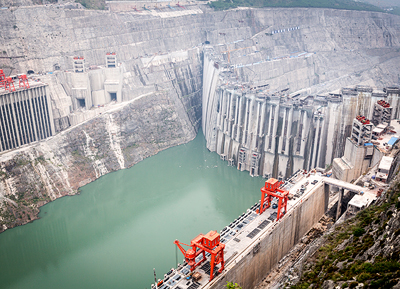Siemens installed gas-insulated high-voltage line hydropower plant in China

Looking upstream on the Jinsha Jiang River at the Xiloudu Dam, you can see two of the water entry openings. The dam filling with water is ongoing.
Photo by Siemens AG Energy Sector
Siemens Energy has completed the testing and installation of a gas-insulated high-voltage line (GIL) with a single pole tube length of 3.2 kilometers. The hydropower plant “Jinping I” in the Liangshan Yi district of the Sichuan province in China, is home to the world’s highest dam wall. The specially-designed GIL consists of a vertical section, approximately 230 meters, with three parallel systems spanning the shaft. The high-voltage transmission system transits 3500 megavolt ampere (MVA) of power at a voltage of 550 kilovolts (kV). A GIL’s high performance allows it to transmit larger amounts of energy than cables — in this case, between the base of the 305-meter-high dam wall and the overhead line at the dam’s water level.
Located at an elevation of 1,800 meters in western China, the Jinping I Hydropower Plant was connected to the State Grid of China and started generating power in August 2013. With a capacity of 3.6 gigawatts (GW), this was the third hydropower plant put into operation since 2000 for Yalong River Hydropower Development Company. The underground hydropower plant is an important element in the Southern Corridor of the West-East Electricity Transfer Project in China.
In order to transport electricity from the dam to the city-centers in the eastern part of the country, power needed to first be carried from the turbines, located in the cavern of the power plant, to the overhead transmission lines 230 meters above. This was accomplished with a total of three, three-pole GIL systems from Siemens installed vertically in two, 230-meter-deep shafts. Each system is capable of safely and efficiently transmitting 2200 MVA to the overhead power lines, and ensures a reliable connection of the power plant at the cavern floor to the grid.
Welding the GIL’s aluminum tubes is an innovative, high-tech process that requires clean-room conditions, which is challenging at a construction site. Siemens installed a large number of temporary tarpaulins and painstakingly maintained site cleanliness throughout the entire installation in order to achieve the highest welding quality.
Gas-insulated transmission lines are especially well-suited for cavern power plants. Fewer systems are required due to GIL’s large transmission capacity. Compared to high-voltage cable solutions, GIL’s tunnel shafts significantly reduce the space needed for transmission routes. Additionally, GIL tubes are not flammable, and do not present a fire load, greatly reducing hazard to operating personnel. The tunnel for the insulated high-voltage lines can also be used as ventilation and service shafts.
Offering a broad range of benefits, GIL provides optimal values for electromagnetic compatibility, increased earthquake resistance, a leak-tight design due to its welding process, and minimal aging.
GIL tubes are produced using seamless welding along their entire length. This not only boosts operational safety, it also lends the GIL a certain degree of flexibility. This means it can, if needed, conform to changes to the tunnel wall. GILs can be used for any kind of terrain, including long distances or inclines as well as vertical sections.
Power Transmission and the associated service are part of Siemens’ Environmental Portfolio. Around 43 percent of its total revenue stems from green products and solutions. That makes Siemens one of the world’s leading providers of eco-friendly technology.
For more information, please visit http://www.energy.siemens.com.
News Categories
- » NEWS HOME
- » Automation & Robotics
- » Industry 4.0
- » Material Handling
- » Sensors
- » Quality & Testing
- » Machine Vision
- » Laser & Optics
- » Metalworking
- » Motion Control & Drives
- » Hydraulics & Pneumatics
- » Process Industry
- » Renewable Energy
- » Agriculture
- » Home & Office Furniture
- » Environmental Tech



